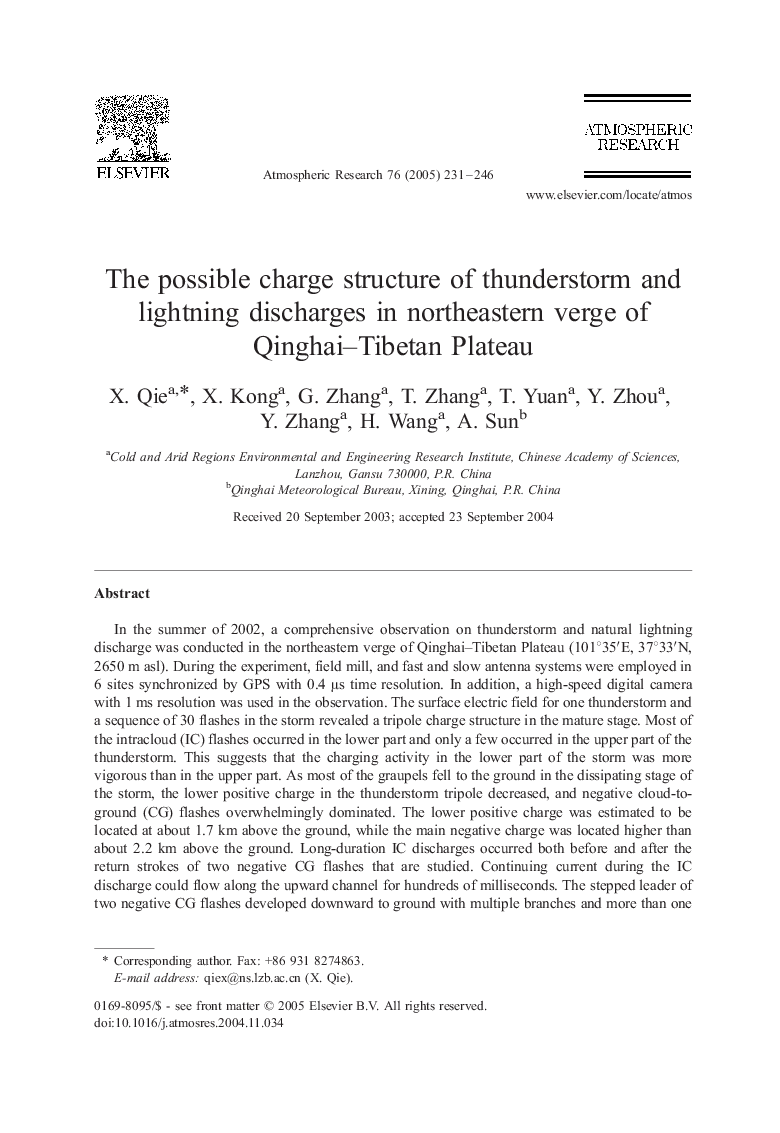| کد مقاله | کد نشریه | سال انتشار | مقاله انگلیسی | نسخه تمام متن |
|---|---|---|---|---|
| 9459798 | 1620586 | 2005 | 16 صفحه PDF | دانلود رایگان |
عنوان انگلیسی مقاله ISI
The possible charge structure of thunderstorm and lightning discharges in northeastern verge of Qinghai-Tibetan Plateau
دانلود مقاله + سفارش ترجمه
دانلود مقاله ISI انگلیسی
رایگان برای ایرانیان
کلمات کلیدی
موضوعات مرتبط
مهندسی و علوم پایه
علوم زمین و سیارات
علم هواشناسی
پیش نمایش صفحه اول مقاله

چکیده انگلیسی
In the summer of 2002, a comprehensive observation on thunderstorm and natural lightning discharge was conducted in the northeastern verge of Qinghai-Tibetan Plateau (101°35â²E, 37°33â²N, 2650 m asl). During the experiment, field mill, and fast and slow antenna systems were employed in 6 sites synchronized by GPS with 0.4 μs time resolution. In addition, a high-speed digital camera with 1 ms resolution was used in the observation. The surface electric field for one thunderstorm and a sequence of 30 flashes in the storm revealed a tripole charge structure in the mature stage. Most of the intracloud (IC) flashes occurred in the lower part and only a few occurred in the upper part of the thunderstorm. This suggests that the charging activity in the lower part of the storm was more vigorous than in the upper part. As most of the graupels fell to the ground in the dissipating stage of the storm, the lower positive charge in the thunderstorm tripole decreased, and negative cloud-to-ground (CG) flashes overwhelmingly dominated. The lower positive charge was estimated to be located at about 1.7 km above the ground, while the main negative charge was located higher than about 2.2 km above the ground. Long-duration IC discharges occurred both before and after the return strokes of two negative CG flashes that are studied. Continuing current during the IC discharge could flow along the upward channel for hundreds of milliseconds. The stepped leader of two negative CG flashes developed downward to ground with multiple branches and more than one striking point on the ground were induced as a result. The 2-D progression velocity of stepped leader was estimated to be about 0.8-1.1Ã105 m/s.
ناشر
Database: Elsevier - ScienceDirect (ساینس دایرکت)
Journal: Atmospheric Research - Volume 76, Issues 1â4, JulyâAugust 2005, Pages 231-246
Journal: Atmospheric Research - Volume 76, Issues 1â4, JulyâAugust 2005, Pages 231-246
نویسندگان
X. Qie, X. Kong, G. Zhang, T. Zhang, T. Yuan, Y. Zhou, Y. Zhang, H. Wang, A. Sun,